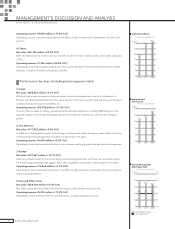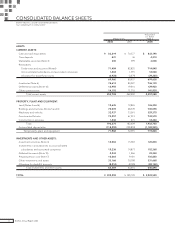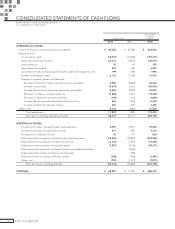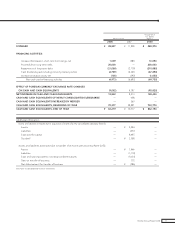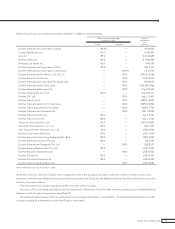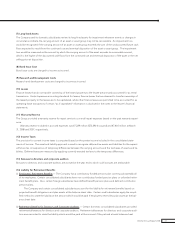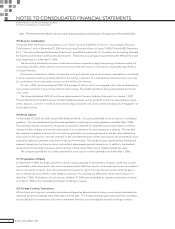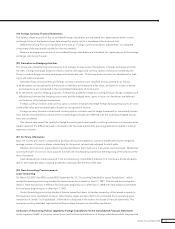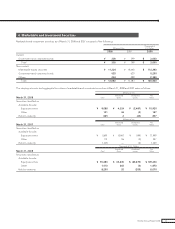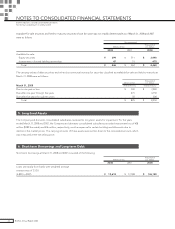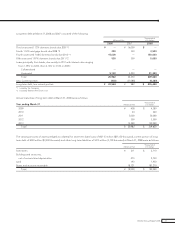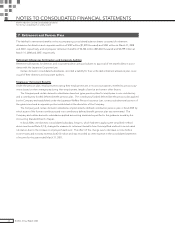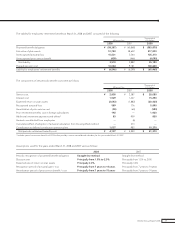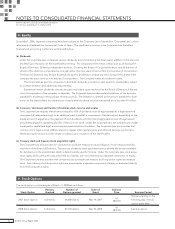Brother International 2008 Annual Report Download - page 22
Download and view the complete annual report
Please find page 22 of the 2008 Brother International annual report below. You can navigate through the pages in the report by either clicking on the pages listed below, or by using the keyword search tool below to find specific information within the annual report.
20 Brother Annual Report 2008
NOTES TO CONSOLIDATED FINANCIAL STATEMENTS
Brother Industries, Ltd. and Consolidated Subsidiaries
For the Years ended March 31, 2008 and 2007
(2) Investments in Unconsolidated Subsidiaries and Associated Companies
Investments in 2 unconsolidated subsidiaries (2 in 2007) and 6 associated companies (6 in 2007) are accounted for by the
equity method.
Investments in the remaining unconsolidated subsidiaries and associated companies are stated at cost. If these
companies had been consolidated or accounted for by the equity method, the effect on the consolidated financial
statements would not have been material.
Accordingly, income from the unconsolidated subsidiaries and associated companies is recognized when the Group
receives dividends. Unrealized inter-company profits, if any, have not been eliminated in the consolidated financial
statements.
(3) Cash Equivalents
Cash equivalents are short-term investments that are readily convertible into cash and that are exposed to insignificant
risk of changes in value.
Cash equivalents include time deposits and free financial funds, all of which mature or become due within three
months of the date of acquisition.
(4) Inventories
Inventories are stated at the lower of cost or market. Cost is determined by the average method by the Company and
consolidated manufacturing subsidiaries. The consolidated sales subsidiaries determine cost by using the average
method or the first-in, first-out method.
(5) Marketable and Investment Securities
Marketable and investment securities are classified and accounted for, depending on management’s intent, as follows:
i) trading securities, which are held for the purpose of earning capital gains in the near term, are reported at fair value,
and the related unrealized gains and losses are included in earnings,
ii) held-to-maturity debt securities, which management has the positive intent and ability to hold to maturity, are report-
ed at amortized cost, and
iii) available-for-sale securities with market values, which are not classified as either of the aforementioned securities, are
reported at fair value, with unrealized gains and losses, net of applicable taxes, reported as a separate component of
equity. Non-marketable available-for-sale securities are stated at cost determined by the moving average method.
For other than temporary declines in fair value, marketable and investment securities are reduced to net realizable value
by a charge to income.
(6) Property, Plant and Equipment
Property, plant and equipment are stated at cost. Depreciation is computed by the declining-balance method.
Property, plant and equipment acquired by the Company and domestic consolidated subsidiaries on and after April 1,
2007 are depreciated by the declining-balance method in accordance with the revised corporate tax law, which is effec-
tive for fiscal years beginning on and after April 1, 2007.
The effect of this treatment was to decrease income before income taxes and minority interests for the year ended
March 31, 2008 by ¥925 million ($9,250 thousand).
The range of useful lives is principally from 3 to 50 years for buildings and structures, from 4 to 15 years for machin-
ery and vehicles and from 2 to 20 years for furniture and fixtures.


